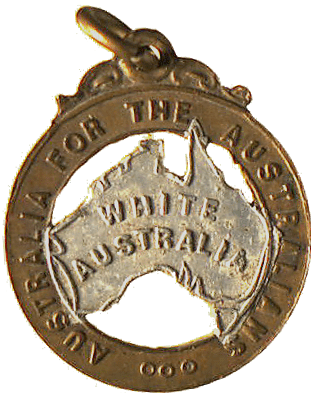What Was the White Australia Policy? A Look at Australia’s Immigration History

You're diving into a defining moment in Australia's past with the White Australia Policy, beginning in 1901, which aimed to preserve racial unity by curbing non-European immigration. Sparked by 1850s gold rush tensions, it fueled anti-Asian sentiment and systemic discrimination through laws like the Immigration Restriction Act and the infamous Dictation Test. Public support, influenced by economic fears and social instability, played an essential role. Though dismantled officially by 1973, its effects lingered in society and policies for years. Engage with Australia's transformation from exclusion to welcoming multiculturalism to truly grasp its profound impact.
Origins of the White Australia Policy
During the gold rush of the 1850s, fears of Asian immigration sparked social tensions in Australia. As thousands of Chinese miners arrived, anti-Chinese laws were quickly enacted, including Poll Taxes and other restrictions. These measures were intended to curb non-white immigration and maintain a mainly white population, reflecting a widespread belief in British colonial ideologies and racial theories. You'll find that these ideologies suggested that non-white immigrants posed a threat to both social stability and economic opportunities for white Australians.
The White Australia policy emerged from this climate of fear and prejudice, where many white Australians viewed Asian immigration as harmful to their national identity. The tensions reached a boiling point with events like the Buckland and Lambing Flat riots, where violence against Chinese miners underscored the depth of societal discord. This public sentiment laid the groundwork for more formalized restrictions.
The Immigration Restriction Act 1901
The fear and prejudice that fueled the White Australia policy soon manifested into concrete legislative action with the introduction of the Immigration Restriction Act in 1901. This crucial piece of legislation was Australia's initial federal attempt to curb non-European immigration and maintain a mainly white population. The Act specifically targeted "prohibited immigrants," a term used to exclude individuals from Asia and the Pacific Islands from entering the country.
Key elements of the Immigration Restriction Act included:
- Dictation Test: This test required non-European migrants to write 50 words in a European language, often set up to guarantee failure.
- Racial Discrimination: The Act institutionalized racial biases within Australia's immigration policies.
- Historical Impact: It led to a significant decrease in non-European immigration, with just 52 successful entries out of 1,359 tests before 1909.
- Longevity: The Act wasn't repealed until 1958, marking a long period of racial exclusion in Australian history.
Implementation of the Dictation Test

Introduced as part of the Immigration Restriction Act of 1901, the Dictation Test became a tool to impose the White Australia policy with precision and bias. Under this test, migrants had to write 50 words in any European language dictated by immigration officers. While seemingly straightforward, the test's implementation revealed its discriminatory nature. After 1905, immigration officers had the discretion to select any European language, which was strategically used to guarantee failure among non-European migrants, particularly those from Asia.
The statistics are telling: out of 1,359 tests administered before 1909, only 52 resulted in successful entries. This starkly illustrates the test's role in racial discrimination within Australian immigration. Failure of the Dictation Test led to immediate deportation, aligning perfectly with the White Australia Policy's aim to limit non-white immigration.
Though there were exemptions, they were not uniformly available to all non-European migrants. The test's design and application were clear efforts to restrict access to Australia, emphasizing the racial biases embedded in the policy. The Dictation Test remained in effect until 1958, symbolizing a period marked by exclusion and racial discrimination in Australia's immigration history.
Exemptions and Exceptions
Australia's immigration policy, riddled with contradictions, allowed certain exemptions and exceptions to the stringent Dictation Test. You'd find that non-European Australian residents who traveled overseas temporarily could return without facing the same scrutiny new migrants endured. This exemption revealed the inconsistent nature of the immigration policy, which was supposed to enforce the White Australia Policy's discriminatory ideals.
Non-European visitors coming for work, education, or family visits also received exemptions. Yet, these exceptions were not applied uniformly, often resulting in painful family separations. Even with a Certificate of Exemption, many non-Europeans risked deportation if they failed the dictation test—an almost impossible feat by design.
- Temporary exemptions further illustrated the policy's bias, creating a tiered immigration system that favored some non-Europeans.
- The dictation test's complexity highlighted the discriminatory underpinnings of the policy.
- Certificates of Exemption were a lifeline for some, but not a guarantee against family separations.
- While temporary exemptions existed, many non-European migrants still lived under the threat of deportation.
The White Australia Policy's exemptions and exceptions underscored its fundamental unfairness, revealing a system that was as capricious as it was cruel.
Public Sentiment and Support
During the late 19th and early 20th centuries, public sentiment in Australia overwhelmingly supported the White Australia Policy. You'd find that a significant majority of white Australians believed non-white immigration threatened social stability and job opportunities. Anti-Asian sentiment played a substantial role, particularly after the gold rush, leading to violent events like the Buckland and Lambing Flat riots, where fears of competition from Chinese miners were rampant.
Trade unions were key players in advocating for the policy. Blue-collar workers feared that non-white labor would undercut their wages and job security. They believed that a "white Australia" was crucial for safeguarding their livelihoods. Public campaigns and political rhetoric further reinforced this idea, emphasizing the need for national unity and identity in the face of perceived foreign influence and invasion threats.
Legislative Changes and Reforms
How did Australia's immigration policies transform from exclusionary to inclusive? It all began with dismantling the White Australia Policy, initially established by the Immigration Restriction Act of 1901. This act sought to limit non-European immigration, using tools like the infamous dictation test. From 1901 to 1958, this test barred countless immigrants. Remarkably, only 46 out of 805 tests were successful in the early years. But change was on the horizon.
The turning point came with the Migration Act of 1958. This significant piece of legislation repealed the Immigration Restriction Act and abolished the dictation test, opening the door for more inclusive practices. The path to a multicultural society received further momentum with the Racial Discrimination Act of 1975, which outlawed race-based discrimination in immigration, marking a complete legislative overhaul.
Key developments include:
- Migration Act of 1958: Abolished the dictation test, fostering inclusivity.
- Racial Discrimination Act of 1975: Ended institutional racism in immigration.
- Whitlam government (1973): Officially renounced the White Australia Policy.
- Legislative overhaul: Paved the way for non-European immigration and a multicultural society.
Through these immigration reforms, Australia welcomed a diverse new identity.
Post-War Policy Adjustments

Many essential changes followed World War II, reshaping Australia's immigration landscape. You might've noticed how the post-war period marked the beginning of the end for the rigid White Australia Policy. Under the leadership of Immigration Minister Arthur Calwell, Australia started to relax its strict immigration restrictions, allowing European refugees to migrate. This shift was significant, as the 1949 amendments to the Immigration Restriction Act permitted limited non-European immigration for the initial time, signaling a gradual loosening of the policy.
The momentum continued with the Holt Government's initiatives in 1966. The Migration Act 1966 introduced non-racial criteria for immigration applications, further eroding the basis of the White Australia Policy. This was a critical moment, as it began to open doors for individuals regardless of their racial backgrounds.
Prime Minister Gough Whitlam played a vital role in steering Australia towards multiculturalism. By 1973, he formally declared the White Australia Policy "dead," and his government made significant strides towards embracing diversity. The Racial Discrimination Act 1975 followed, establishing legal equality in immigration processes and outlawing racial discrimination in citizenship practices. These post-war adjustments laid the groundwork for a more inclusive and diverse Australia.
Final Dismantling of the Policy

The final dismantling of the White Australia Policy was an essential moment that reshaped the nation's identity. This change began with the repeal of the Immigration Restriction Act in 1958, marking a decisive shift away from policies rooted in racial discrimination. The Whitlam government took a bold stance in 1973, declaring the White Australia Policy "dead" and embracing multiculturalism as a cornerstone of Australia's future. The Racial Discrimination Act of 1975 further reinforced this commitment by outlawing racial discrimination in immigration processes, paving the way for a more inclusive society.
Key milestones during this period include:
- The repeal of the Immigration Restriction Act, which removed significant immigration restrictions.
- The introduction of the Racial Discrimination Act in 1975, eliminating institutional racism.
- Legislative changes that encouraged non-European immigration, diversifying the demographic landscape.
- By 1981, a notable increase in Australia's non-European population, more than doubling since 1947.
These legislative changes after World War II gradually opened the doors for non-European immigration, allowing Australia to evolve into a lively multicultural society. By 1981, the demographic landscape had transformed remarkably, reflecting the profound impact of dismantling the White Australia Policy on its population and cultural fabric.
Impact on Australian Society

With the dismantling of the White Australia Policy, Australian society experienced a transformative shift that welcomed multiculturalism and diversity. You saw a move away from the immigration restriction that had once limited non-European migrants, resulting in a more inclusive society. The dictation test, a notorious tool of racial discrimination, was phased out, allowing for a more varied population to settle and thrive. This change marked the beginning of a significant demographic shift, as non-European migrants, including a substantial number from Asian countries, began to call Australia home.
Previously, systemic discrimination against Indigenous Australians and non-European migrants had shaped societal attitudes, leaving a legacy of racism that lingered for decades. However, by the 1970s, the introduction of the Racial Discrimination Act 1975 signaled a profound cultural shift. It outlawed racial discrimination and fostered an environment where multiculturalism could flourish. Today, Australian society is characterized by its lively cultural tapestry, with approximately two-fifths of immigrants being of Asian descent by the early 21st century.
This shift toward a more inclusive society not only enriched the cultural landscape but also challenged the historical narrative shaped by the White Australia Policy, paving the way for a more diverse and equitable nation.
The Policy's Lasting Legacy

Decades after its abolition, the White Australia Policy's legacy still echoes in the nation's cultural and demographic landscape. Officially established by the Immigration Restriction Act of 1901, this policy sought to maintain a racially homogenous society by severely limiting non-European immigration. Its effects were stark, with the Asian population in Australia dropping to a mere 0.21% by the late 1940s, showcasing its success in reducing cultural diversity.
Despite its formal abolishment in 1958, the shadow of the White Australia Policy lingered, but it also paved the way for significant shifts towards a multicultural society. The enactment of the Racial Discrimination Act in 1975 was crucial, dismantling institutional racism and promoting equality in immigration processes. This change marked a new chapter in Australia's immigration history, leading to dramatic demographic changes where today approximately 40% of immigrants are of Asian descent.
The policy's lasting legacy can be observed in:
- The shift from a racially homogenous society to a multicultural one.
- The significant increase in cultural diversity post-policy.
- The role of the Racial Discrimination Act in addressing past injustices.
- The continued impact on Australia's demographic composition and identity.




